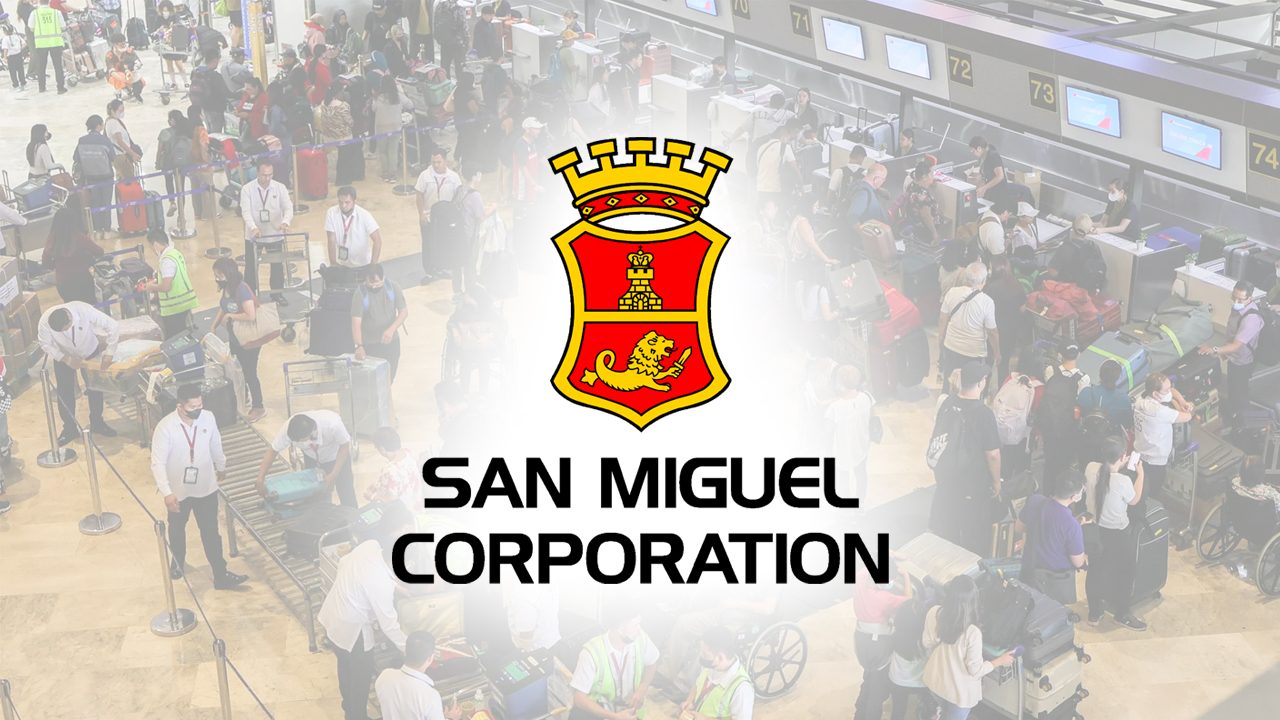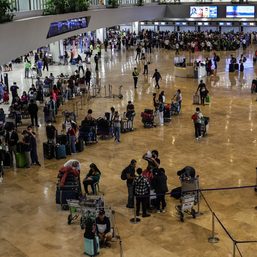SUMMARY
This is AI generated summarization, which may have errors. For context, always refer to the full article.

MANILA, Philippines – It’s official: the consortium led by San Miguel has won the bid to rehabilitate the Ninoy Aquino International Airport (NAIA), which has long languished as one of the worst and “most stressful” airports in the world.
The Department of Transportation issued the Notice of Award for the NAIA privatization to SMC-SAP Company Consortium on Friday, February 16, capping off one of the fastest solicited private-public partnership projects in the history of the Philippines.
The latest push to fix up the country’s main airport started just on February 2, 2023, when the government signed its transaction advisory services agreement with the Asian Development Bank. Just over a year later, a winning bidder has emerged.
Now, Ramon Ang’s mega-conglomerate, along with South Korea’s Incheon International Airport Corporation, will have up to 25 years to upgrade and optimize NAIA. What are the first steps?
What changes can we expect from NAIA?
Under the terms of the P170.6-billion deal, the San Miguel conglomerate will make improvements to the airport’s runways, four terminals, and other facilities in areas ranging from construction, supply, operation, and maintenance.
According to Transportation Undersecretary for Planning and Project Development TJ Batan, the agreement is not so much about building specific things but about delivering services.
“Let’s start from the time that you arrive in the airport. We have a performance indicator on availability of parking. So you should be able to find parking within X amount. When you enter the airport, you should line up within a certain amount. You go through immigration, you go through security; there’s also an amount of time that’s prescribed for that. When you’re arriving, there’s a prescribed amount of time when the first and last baggage from the plane to the conveyor should come up,” Batan said during Friday’s press conference.
“You have these performance indicators as well as availability. Your passenger boarding bridges, your escalators, your elevators should be operational 95% to 99% of the time. Your air conditioning, your lighting should be working this amount of time,” he added.
More specifically, the NAIA rehabilitation is expected to increase airport capacity from 35 million passengers per annum to 62 million, improve air traffic movements per hour from 40 to 48, and make service meet international benchmarks.
Batan explained that in meeting these performance indicators, the concessionaire will likely build better infrastructure and incorporate “technology improvements.”
When will San Miguel take over the airport?
San Miguel’s group is expected to assume operation of the airport within the next three to six months.
In the meantime, the consortium will be doing its financial closing as well as ironing out the details of the takeover, which will involve the transfer of employees from the current operator – the Manila International Airport Authority (MIAA) – to the SMC-SAP Company Consortium.
“There are employees of NAIA who will join them and employees of NAIA who will remain with the MIAA as a regulator. So it will take three to six months. But we’ll try our best to do it as early as possible so that we can start the operations and maintenance of this project in the private sector,” Transportation Secretary Jaime Bautista said.
Once the takeover is complete, the consortium’s first order of business is to work on “quick gains” or low-hanging fruit service improvements within the first year.
San Miguel will then have 15 years to operate the airport, which can be extended by another 10 years. Whether an extension is granted or not will depend on a performance evaluation that will be conducted on the 8th year of the concession period.
Will passenger fees go up?
In making the winning bid for the airport, San Miguel’s group bet big, committing to share 82.16% of its gross revenue with the government, on top of an upfront payment of P30 billion and a fixed annual payment of P2 billion.
Asked whether this privatization deal could lead to higher fees for passengers, MIAA General Manager Eric Ines admitted that a rate hike is on the table.
“Actually, the MIAA has not raised its rates since April 2000. So we thought it’s about time that we should try to raise some rates in accordance [with] what had already been computed before, but was never implemented,” Ines said on Friday.
The airport chief said that increases are expected for “rentals, navigational charges, all of it,” but he said that as far as he knows, there will be “no change” to the passenger service charge. Currently, travelers must pay a terminal fee or passenger service charge of P200 for domestic trips and P550 for international trips.
According to Ines, MIAA is still evaluating the impact of the planned increase to end users, but that it would “not be too big.”
MIAA has yet to release the proposed fee changes to the media.
Is San Miguel’s bid financially viable?
The bid by San Miguel’s group is certainly favorable to the government, with the NAIA deal expected to generate P900 billion all in all, or over P36 billion per year for 25 years. In comparison, when MIAA used to operate the airport, it remitted only an average of P1.78 billion per year from 2010 to 2023.
Will San Miguel be able to sustain itself? Undersecretary Batan argued that “private sector efficiencies and ingenuity” has repeatedly shown that it can provide “solutions to government problems.” Batan also said that the bid committee studied the financial plan of the bidders and assessed the willingness of lenders to lend to the bidder for the project.
“We also look at the financing plan to see whether the funding sources of the bidder, now the winning bidder, also makes sense. So, these detailed evaluations were done to make sure that the concessionaire or the winning bidder is able to deliver on their commitments for the project,” Batan said.
Transportation Undersecretary for Aviation and Airports Roberto Lim also clarified that the gross revenue share excludes passenger service charge or terminal fees. This means San Miguel’s group will only have to share 82.16% of the revenue that it earns from other airport fees, like navigation charges and rentals.
“That should put in context the rationale of, I suppose, the bidder in assessing what bid percentage to offer. It’s the gross revenue excluding the [passenger service charge],” Lim said.
Can San Miguel run both NAIA and Bulacan Airport?
Aside from financial concerns, government officials also faced questions about the possible conflict of interest arising from San Miguel operating both NAIA and the soon-to-rise international airport in nearby Bulacan. But Secretary Bautista said he doesn’t think there will be any conflict in operations.
“Bulacan Airport, I think, will not start until maybe 2027 or 2028. But right now, we need to improve Manila International Airport because as you know, it is a very congested airport with a capacity of 35 million passengers per annum handling almost 50 now. We really need to modernize this airport so that we can provide better service to our passengers,” Bautista said on Friday.
The secretary said that modernizing NAIA could raise its capacity to 60 million passengers per annum, but since estimates show that the country will need to service almost 100 million passengers every year by 2050, there is space for another airport.
“We really need another airport. So, I don’t think the operations of Manila International Airport will conflict with Bulacan Airport,” Bautista said.
Who are the 2 obscure partners of San Miguel?
The SMC-SAP Company Consortium has four members: San Miguel Holdings Corporation, Incheon International Airport Corporation, RMM Asian Logistics, and RLW Aviation Development.
San Miguel serves as the lead member and financial qualifying entity for the consortium while Incheon International Airport Corporation, which runs the famed South Korean airport, acts as the operations and maintenance partner. But who are the other two members?
Documents show that both RMM Asian Logistics and RLW Aviation Development were created only last December 2023.
Rappler previously questioned whether Ramon Ang’s consortium might be using these hastily made companies to circumvent ownership limitations outlined in the bidding rules. Because San Miguel already has the Bulacan Airport, it is allowed to have a direct ownership stake of only 33% in NAIA.
Meanwhile, RMM Asian Logistics and RLW Aviation Development each have a 30% and 27% ownership stake, respectively. If these companies were indeed acting as merely nominees, then that means San Miguel could effectively act as if it had a 90% stake in the airport, with the other 10% going to its partner Incheon International Airport Corporation.
When Rappler raised the question of RMM Asian Logistics and RLW Aviation Development’s involvement in the rehabilitation project, Undersecretary Batan said that they are expected to contribute investments.
“RMM and RLW are consortium members that will be putting in equity into the special purpose company that will operate NAIA for the winning bidder. So they are going to put in investment in the special purpose [company],” Batan said.
Both companies only have a meager paid-up capital of P6.25 million based on documents shown during the opening of the financial proposals. – Rappler.com
Add a comment
How does this make you feel?





There are no comments yet. Add your comment to start the conversation.